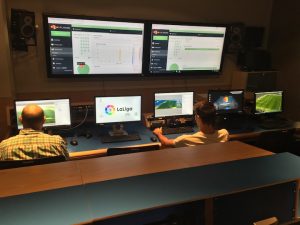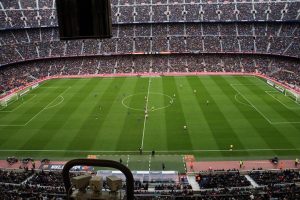‘Tesla for sports broadcasting’: how automated live production is gaining ground
 The autonomous production of sporting events, eliminating the need for an on-site production team, director or camera operator, is making serious headway among professional clubs, federations and leagues. The technology is gaining ground as a tactical and performance analysis tool and increasingly used to fully automate live streamed production.
The autonomous production of sporting events, eliminating the need for an on-site production team, director or camera operator, is making serious headway among professional clubs, federations and leagues. The technology is gaining ground as a tactical and performance analysis tool and increasingly used to fully automate live streamed production.
Spanish soccer league La Liga, for instance, is the first league in the world to introduce an automated production system that is making every game available to any analyst in any of the league’s clubs. Since the beginning of the 2017-18 season all 42 La Liga clubs are using Automatic TV, devised by media group and domestic rights holder Mediapro, for analysis not just post-event but to inform team decisions at half-time.
Keemotion, a U.S company behind a rival automated sports video technology “has the potential to disrupt the way all live events are produced,” claims one of its investors, the former NBA commissioner David Stern. “And that’s not limited to sports. This is a game-changer.”
Speaking to Forbes, Stern also described the ability to automate production as the “Tesla for sports broadcasting”.
MediaPro has informed SVG Europe of major announcements at NAB in April one of which will see the current HD camera system upgraded to UHD and the ability to picture stitch 8K-10K panoramas in real-time.
Aside from La Liga, MediaPro also says its system is in use by two other national European leagues, including a division one, although it said it cannot reveal names. The system is active in the US for gymnastics, Australia for new Olympic sport 3 x 3 basketball, in the UK, Denmark and China.
“We are delivering both tactical camera feeds and live streaming and we provide that to analysts, sports body and coaches of the clubs on a closed network,” explained Joan Bennassar, who initiated the project within Mediapro’s R&D team five years ago.
“The first step was to understand if we were able to make a video production without any human intervention – just a camera and computer and software analysis of what is happening on the pitch. Within a few months we were able to prove that concept.”
A year later Automatic TV was installed at Barcelona FC’s training facility to record all training sessions. “We waited one more year until launching commercially worldwide. We now have distributors in more than 20 countries and are able to create a full HD multi-camera production from different angles.”
Primary applications
There are, Bennasser explains, three primary applications for ATV. “The first is tactical analysis using mainly a master view of the game. Conventional broadcast coverage concentrates on only a few players. You are not normally in a wide shot so you cannot see everything that is happening. As a coach or a scout you want to see all the players all the time.”
La Liga is making most extensive use of this Tactical camera. Software specifically designed to manage a 3-camera fixed rig creates the video feed, which is imported into the video motion analysis tool Mediacoach, also devised by Mediapro.
 The system, which was approved by every club, means each club has access to the same tactical data for all home and away games – though how that is interpreted is up to the skills of club analysts. The feeds are stitched into a 6K x 1K quality panorama controlled remotely by an operator in a purpose-built central control in Madrid. Individual club analysts can view the live stream and provide feedback to the manager at half time. An hour after the final whistle and all clubs are able to access any tactical camera feed from any of the other matches via the Mediacoach platform, while La Liga can deliver the video to all interested broadcasters. Other sports analysis tools including Sportscode, Nacsport, and Fluendo’s Longomatch are also compatible.
The system, which was approved by every club, means each club has access to the same tactical data for all home and away games – though how that is interpreted is up to the skills of club analysts. The feeds are stitched into a 6K x 1K quality panorama controlled remotely by an operator in a purpose-built central control in Madrid. Individual club analysts can view the live stream and provide feedback to the manager at half time. An hour after the final whistle and all clubs are able to access any tactical camera feed from any of the other matches via the Mediacoach platform, while La Liga can deliver the video to all interested broadcasters. Other sports analysis tools including Sportscode, Nacsport, and Fluendo’s Longomatch are also compatible.
The second ATV application is for training. “Typically, during a training session you will have different groups practicing different things simultaneously. ATV can record several video files separately, automatically and simultaneously so that a coach is able, later, to follow for example the goalkeeper training and then some tactical practice or a small match.”
Valencia FC adopted this in its training facility for the start of the 2017-18 season.
The third application is “broadcast-style” live streams using up to 8 HD cameras ringed around the venue. This is being used by clubs as an inexpensive means to stream to official websites. Bennasser says this is typically semi-automated with production by one or two personnel on site – a camera operator filming handheld touchline clips and a vision mixer to switch the feeds.
Automatic TV works with nine sports including hockey, basketball, handball and volleyball. It comes with software to schedule games and links to a manned monitoring site.
It is not as yet offering automated editing of highlights packages although where edits are needed there is capability for an operator to clip selections into a playlist.
“The system can also be used as a low cost video assistant referee system,” says Bennasser. “We can go back in time and analyse any action frame by frame and provide replays.”
MediaPro says its product is commercialised in a small but competitive and fast growing market. Other technology providers in this area include Pixellot – which supports 12 sports for broadcasting and coaching, as well as multiple camera capability that enables actual automatic production without anyone needing to be on the court – and Keemotion.
‘Motion Following Technology’
Keemotion is based on a proprietary ‘Motion Following Technology’ which detects and tracks player movements, and follows the game through additional scoreboard interaction. The technology enables coaches to break-down, analyse and share game footage real-time, while fans can simultaneously watch the event and connect it with others through social media. Games are available either live or on-demand, and accessible for web streaming and mobile distribution.
The system – recently backed with $3.6 million of funds from investors including Guggenheim Baseball Management, the Los Angeles Dodgers and David Blitzer, co-owner of the Philadelphia 76ers and New Jersey Devils – is being used within both divisions of the men’s pro basketball league in France (LNB Pro A and Pro B) and by all 12 teams in the LFB, the women’s pro basketball league in France. Across all three leagues, Keemotion has taken the production of French basketball from four games per week to over 20.
Keemotion works with basketball, ice hockey volleyball, handball and futsal and the new funds will be used to address more sports.
The Brooklyn-based outfit currently produces basketball games and other sporting events for professional leagues, colleges and universities and high schools in nine countries – the U.S, France, Italy, Germany, Austria, Finland, Belgium, England, and The Netherlands. Its European customers include Bayern Munich, the Austrian Basketball League and the Finnish Basketball Association. It says it also works with content distribution partners including Sky Austria and Dailymotion.
Meanwhile, Keemotion is in early-stage conversations with a number of technology companies to figure out how its technology might potentially be used more broadly in film production, sports and consumer technology, or how technology such as deep learning and artificial intelligence might help to improve its product and accelerate the development of its automated technologies.
